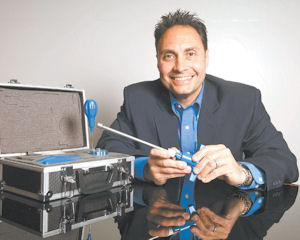ECA Medical Instruments got its start making precise surgical instruments that were packaged with pacemakers. After every pacemaker operation, the tool was tossed out. Now the $12 million Newbury Park company wants to bring disposable surgical instruments to the much bigger orthopedics market, where it hopes its new single-use instruments will cut soaring health care costs and tap into the need by hospitals to reduce hospital-acquired infections. ECA has spent the last two years identifying a market in health care that was ripe for cost containment. After settling on orthopedics, it went to work creating a line of disposable instruments. With the product ready to launch, it is now rolling out a marketing campaign to convince hospitals, original equipment manufacturers and those who make orthopedic implants that despite the green movement, single-use surgical instruments make business sense. “The savings to a hospital on a per kit basis is hundreds of dollars per instrument,” said John Nino, president and CEO of the company. With orthopedics accounting for most surgeries at any one hospital, he believes the market opportunity before ECA is as much as $200 million and that ECA is positioned to double revenues in five years. It remains to be seen whether surgeons will be ready to switch, however. Orthopedists rely on the strength that comes with medical-grade steel instruments that are used to attach bones. An instrument made partly of plastic — no matter how strong — may be a difficult sell. But ECA is not just selling hospitals on the idea of savings. It is also selling safety. Hospital-acquired infections kill thousands of people a year and cost more than $5 billion, according to the Centers for Disease Control and Prevention, though some studies have put the numbers as high as $25 billion. According to the CDC, 1.7 million people get some kind of hospital-acquired infection every year. About 274,000 of those come from surgical site infections. ECA says 6 to 10 percent of all hospital acquired infections are due to the use of reusable instruments. “This is a real hot button issue for hospitals,” said Douglas Slomski, vice president of sales and marketing at ECA. “There are new regulations in place under which every hospital-acquired infection has to be followed by a forensic analysis to see where the infection started. If they find that the hospital caused the infection, the cost has to be completely born by the hospital. It’s an extremely high-risk venture to make sure they’re not introducing any infections.” ECA is banking on that as its executives travel the country selling the idea of disposable orthopedic surgical instruments. To the notion that single-use instruments are not as strong, Nino has an answer. He says ECA has spent years perfecting the manufacture of injection molded plastics, which when combined with stainless steel, results in a very strong polymer. “We have a lot of experience in getting strength out of plastic,” Nino said. Some of that experience comes from the company’s core business making torque limiting wrenches for pacemaker surgeries. But some of the experience is newly developed since the company’s $50 million acquisition in 2005 by American Capital Strategies of Bethesda. Nino was a manufacturing turnaround expert, who has introduced lean manufacturing techniques, enterprise resource planning, and even a new robotic “end of arm” tooling to ECA. ECA hopes to package its line of single-use surgical wrenches in hermetically sealed kits that include not just the wrench, but also the fasteners, the brackets that hold bones together and even the implants themselves such as the Zimmer knee. After each use, the wrenches and instruments made by ECA are simply tossed out. Nino says tossing the instrument is far better than the current process for reusing surgical orthopedic instruments, in which the instrument is sterilized, calibrated and sent back to the manufacturer, who repeats the same process before repackaging the instrument to ship it back to the hospital. Nino says a reusable limited torque wrench – which allows a surgeon to apply just the right amount of pressure to attach a prosthetic – costs ten times what a disposable wrench would cost. In addition, there is the cost of cleaning, shipping and repackaging with every use. Something else most people don’t know, he said, is that a manufacturer’s representative—someone who typically earns $200,000 a year or more—has to be present at every single surgery that involves the use of the tool, Nino said. With a disposable tool, all those costs are eliminated, he said. “It takes the burden off the hospital to make sure the kit is properly prepared with everything the surgeon needs.”
